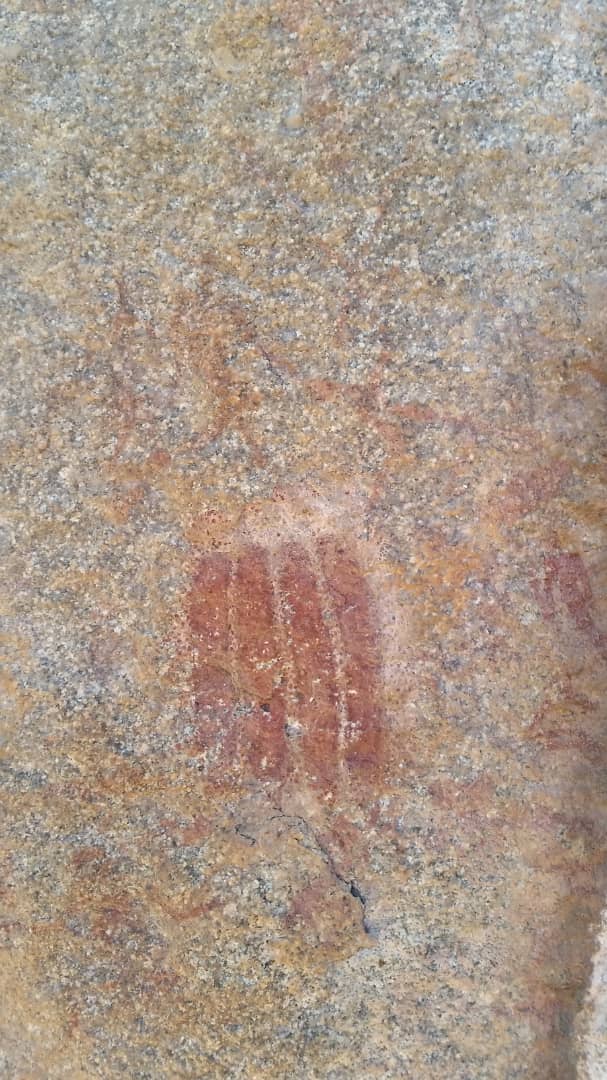Historian and teacher Nimorod Ushe, a native of the area has put pen to paper to document rock sites in the Chikuku area under Bikita District. Below Spiked Online Media reproduces the historian’s perspectives:
Chikuku rock sites are located along Masvingo-Mutare highway approximately 33km east of Nyika growth point in Bikita District of Masvingo Province. Chikuku literally mean ‘Little Chicken’ (and some locals claimed that it was named after a small chicken which used to disappear mysterious in that place). Chikuku rock art sites are under the traditional authorities of village headman Banga and Tochiona. Both sites are also presided by headman Mamutse and Chief Mazungunye of the VaDuma Clan. Results from this paper can exclusively reveal that there are two rock art sites, the rock paintings at Chimungoza mountain and rock engravings at Chinyamakozha. The rock paintings consist of visible and invisible images of plants, humans, animals and geometric objects. And rock engravings comprise of “human foot prints” and “cupules or grooves ” on the rock surface.
The Chikuku rock painting is on a 9m on length and 7m wide rock boulder and the site is accompanied by caves. The basic paints which were used by the artists were red, black, yellow and white. Research has shown that rock art was used by the hunter gatherer groups as historical, educational, informative, entertainment medium for their community. (Hunter- gatherer in Zimbabwe are still known from the western parts of the country along the Zimbabwe -Botswana border in Tsholotsho. And they are known as Masarwa/ Basarwa)
Animal depictions at the site consists of various species mainly the kudu and animals from the antelope family. There are visible images of the big game and also intermediate animals. The biggest animal is 30 cm long and the thinnest images is at least 5cm. Apart from that, representation of geometric designs such as dots, circles and lines are also observed at Chikuku rock art and there is an outstanding geometric image of a skirt.
Significant tools such as, hand axes, scrappers, cleavers and blades are found at the site. These are characterised by thinner, more symmetry and trimmed tools. Some of the reshaped stone tools which were found at the site had traces of the paint which was used by the artists. One would be tempted to conclude that the appearance of such assemblages is largely associated with the Late Stone Age period and the Early Iron Age which can be dated around (AD 1000 -1200) as indicated by many archaeologists of the past.
Apart from rock paintings there is also rock engravings which is a site of 9m by 6m near a rock cliff. This site which comprise of “cupules or grooves, human foot prints” and “animal tracks” on the rock surface. And there are about 200 cupules (saucer-shaped depression). Moreover, there are also smooth, ‘scorn –shaped’ indentions with rounded bottoms, usually about 18cm long and were probably made by grinding with a hard, blade-shaped stone. There are 8 sets of grooves which be equated to “Jack” pits with 7 ‘dots’ at the bottom.
It is important to note that this type of art was commonly practiced by the ancient KhoiSan people and it represent their earliest form of creativity in artist work. There are notable features such as human footprints consist of 6 feet of adults and probably children. The notable human footprint is 28cm long and 14cm wide on its midsection. Both feet of an adult were artistically drawn on rock surface at the site.
They are depicted facing up through the area like they were walking out of the nearby rock boulder onto earth. Prior to this Village headman Tochiona noted that “Chikuku rock engravings can tell the amazing history of the country.
One would wonder “how did they executed this type of art?” Sometimes it appears as if someone stepped on the rock surface whilst it was wet. “It has the ability for people to see and interpret for themselves “. And It has the potential of attracting tourist to the area.” This place is also capable of furnishing information or knowledge which has not been found in other rock art sites in country.
Although, Chikuku rock art was magnificently painted many years ago, the rock paintings in is currently affected by weathering, water damages on surface and exposure to sunlight. Moreover, some sections of the rock engraving at Chikuku appears to have been vandalised by people who used the stones for various domestic uses. One of heritage manager Nyati pers com (2020) also asserts that Zimbabwe was also losing much of rock paintings in the Western Region due to varying people behaviors such as vandalism and graffiti. She noted that ‘heritage professional should increase the care for these sites as possible as they can’.
Chikuku rock art site have been affected by natural hazards such as cyclones over the past years. Although it can be difficult to ascertain the extent of damage caused by cyclones on rock art site. It can be safe to say that cyclonic rainfalls were capable of weaken rock particle and also fuelling the weathering process at the site.
Fortunately, heritage professionals at Matopos (a place where largest concentration of rock art is found in the country) are working on a World Heritage Monument fund project and they are largely focusing on documenting rock art for management or specifically for conservation purposes.
This project allows heritage professionals to keep track how rock art sites are responding the ever changing climatic conditions, people behaviour and also help them to keep a virtual record in case of natural disasters like cyclonic rainfalls. In a nutshell, Chikuku rock art sites remain as the country’s untapped cultural resources. The Zimbabwe government should strive to provide tourism and recreation opportunities at some of rock art sites in rural areas. This will enhance employment creation, economic development, learning and foster cultural identity and sense of place for the poor communities where most of rock art sites are located.






